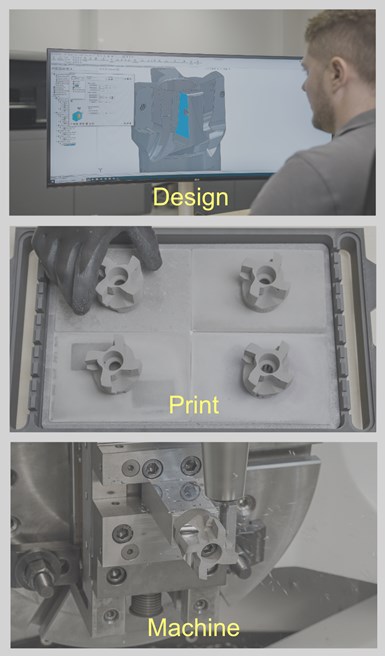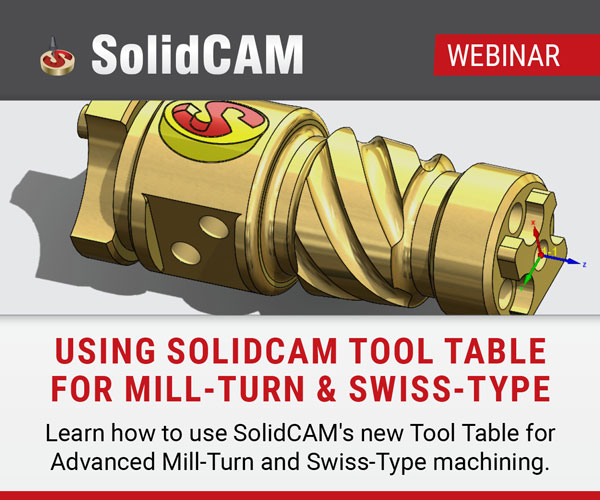Taking the Leap into Additive Manufacturing
Sponsored ContentSolidCAM’s partnership with Desktop Metal, and its in-depth experience in combined metal 3D printing and CNC finishing, is aimed at making additive manufacturing accessible and profitable for job shops and other manufacturers.
Share

SolidCAM intends to assist job shops with the entire art-to-part process – from design to 3D printing to post-process CNC machining – all working off the same solid model. This service will help reduce the time, effort, and risk of bringing additive manufacturing into a traditional machine shop.
If you're a job shop or other high-mix machining operation, sooner or later you're going to have to consider bringing additive manufacturing into your production capabilities portfolio. If you're in the prototyping business, you already know that. But AM is becoming increasingly relevant in low-to-medium volume production. Shops that don't have it will grow increasingly uncompetitive for many jobs.
Leading CAM developer SolidCAM wants to help make the journey to adopt Additive Manufacturing feasible and profitable. According to Founder and CEO, Dr. Emil Somekh, “SolidCAM views Additive Manufacturing as a complement to our 20,000 CNC subtractive manufacturing customers worldwide. The ability to 3D Print complex metal parts, with speed and repeatability, and then post process them with CNC finishing, is now within reach of even the smallest job shops and we have committed to becoming a leading resource in this space for our SolidCAM CNC customers.”
Deeper Knowledge Through Partnership
What does that mean? First, SolidCAM has formed a partnership with Desktop Metal to leverage its metal binder jetting technology. Desktop Metal's Shop System is the first such AM platform specifically designed to bring metal 3D printing to machine shops. Dr. Somekh says that Desktop Metal has invested heavily in simplifying a complex process to allow for increased productivity and throughput of parts, with limited operator involvement.
Both companies recognize that taking on additive manufacturing involves much more than dropping a metal 3D printer on your shop floor. There is a full slate of issues that come with building an internal additive manufacturing infrastructure such as:
- How to pick the right parts that are suitable for AM applications.
- How to manage the total metal AM process – from model preparation to 3D metal printing and sintering of parts to post-processing by CNC machining.
- How to design parts that take advantage of additive manufacturing’s special capabilities.
- How to optimize the total process and ensure that the highest throughput and quality standards are met.
A big problem for job shops exploring Additive Manufacturing has been that 3D printing systems vendors tend not to sufficiently appreciate the demands of a job shop environment. A job shop needs to quickly find process solutions for a part and execute production expeditiously at an acceptable cost. For precision parts, Additive Manufacturing alone only gets you partway there. Because SolidCAM already works with job shops every day, they understand the needs and can help guide shops to an art-to-part process that makes sense, and that makes money.
Integrating the Entire CAD to Part Process
SolidCAM’s integrated approach to CAD/CAM provides a significant advantage. Its CAM functionality runs inside the widely used solid modeling CAD systems SOLIDWORKS and Inventor, both of which have robust design-for-AM capabilities. This frees users to apply the best design tools while leveraging the same 3D model for sophisticated CNC programming functions, such as SolidCAM’ s well-regarded and unique iMachining, and its Advanced Multi-Channel Mill-Turn & Swiss solutions. The company is also developing a new SolidCAM module that supports hybrid machines, where CNC machining and 3D printing occur on the same platform.
This penchant for integration meshes well with Desktop Metal’s holistic approach to Additive Manufacturing – from the creation of proprietary metal powders to the sintering of parts in its advanced Furnace solution and the first-of-its-kind Live Sinter application. Live Sinter uses a multi-physics engine capable of simulating the complex forces and deformation that parts experience during sintering, and automatically generates “negative offset” geometry which, when sintered, results in straight, defect-free parts.
In additive manufacturing, as well as CNC machining, technique can be as important as technology, and SolidCAM has the experience to assist and train job shops with the best use of the combination of these two technologies. To that end, SolidCAM has set up several CNC + AM Manufacturing Centers of Excellence in Germany, US, and additional locations. These R&D and Service Centers will teach shops how to implement Additive Manufacturing technology on their parts, exposing the advantages of using the combined metal 3D printing and CNC machining technologies, in the process to convince the customer to do this commitment. Says Dr. Somekh, “Through combining the two technologies, companies can solve complex engineering and manufacturing problems in new and innovative ways. Metal 3D printing will always need post-processing with CNC machining to ensure the parts are to the finish specifications the customer requires. SolidCAM is positioned as the leader in CAM solutions, adapting its software technology to effectively CNC Post-Process, for the growing market of 3D printed metal parts.”
Please visit the website to learn more about SolidCAM Additive Manufacturing Solutions.

